HLTINF001 Comply with Infection Prevention and Control Procedures
VerifiedAdded on 2023/06/10
|54
|9862
|329
Practical Assignment
AI Summary
This assessment workbook for HLTINF001 focuses on complying with infection prevention and control policies and procedures within a healthcare setting. It covers key areas such as following standard and additional precautions, identifying infection hazards, assessing risks, and implementing procedures for managing those risks. The workbook includes both a knowledge assessment with short answer questions designed to test understanding of infection control principles and a practical assessment involving identifying hazards, conducting risk assessments, managing risks through control measures, and documenting/reporting findings. The practical assessment uses case studies and simulations to provide a real-world context for learning and application, ensuring students can effectively apply infection control measures in their work environment. The document is contextualized for Inspire Education RTO 32067.
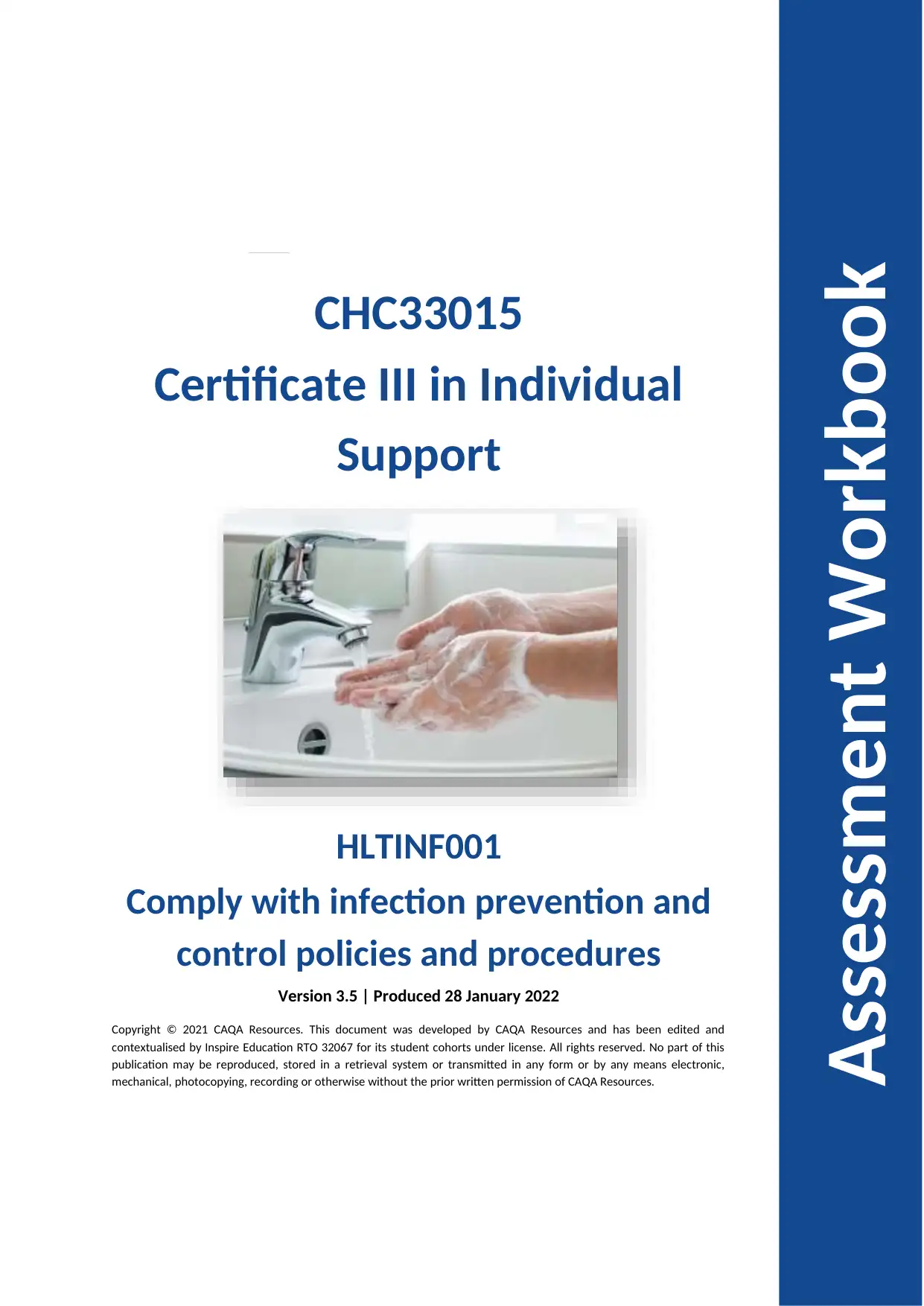
CHC33015
Certificate III in Individual
Support
HLTINF001
Comply with infection prevention and
control policies and procedures
Version 3.5 | Produced 28 January 2022
Copyright © 2021 CAQA Resources. This document was developed by CAQA Resources and has been edited and
contextualised by Inspire Education RTO 32067 for its student cohorts under license. All rights reserved. No part of this
publication may be reproduced, stored in a retrieval system or transmitted in any form or by any means electronic,
mechanical, photocopying, recording or otherwise without the prior written permission of CAQA Resources.
Assessment Workbook
Certificate III in Individual
Support
HLTINF001
Comply with infection prevention and
control policies and procedures
Version 3.5 | Produced 28 January 2022
Copyright © 2021 CAQA Resources. This document was developed by CAQA Resources and has been edited and
contextualised by Inspire Education RTO 32067 for its student cohorts under license. All rights reserved. No part of this
publication may be reproduced, stored in a retrieval system or transmitted in any form or by any means electronic,
mechanical, photocopying, recording or otherwise without the prior written permission of CAQA Resources.
Assessment Workbook
Paraphrase This Document
Need a fresh take? Get an instant paraphrase of this document with our AI Paraphraser
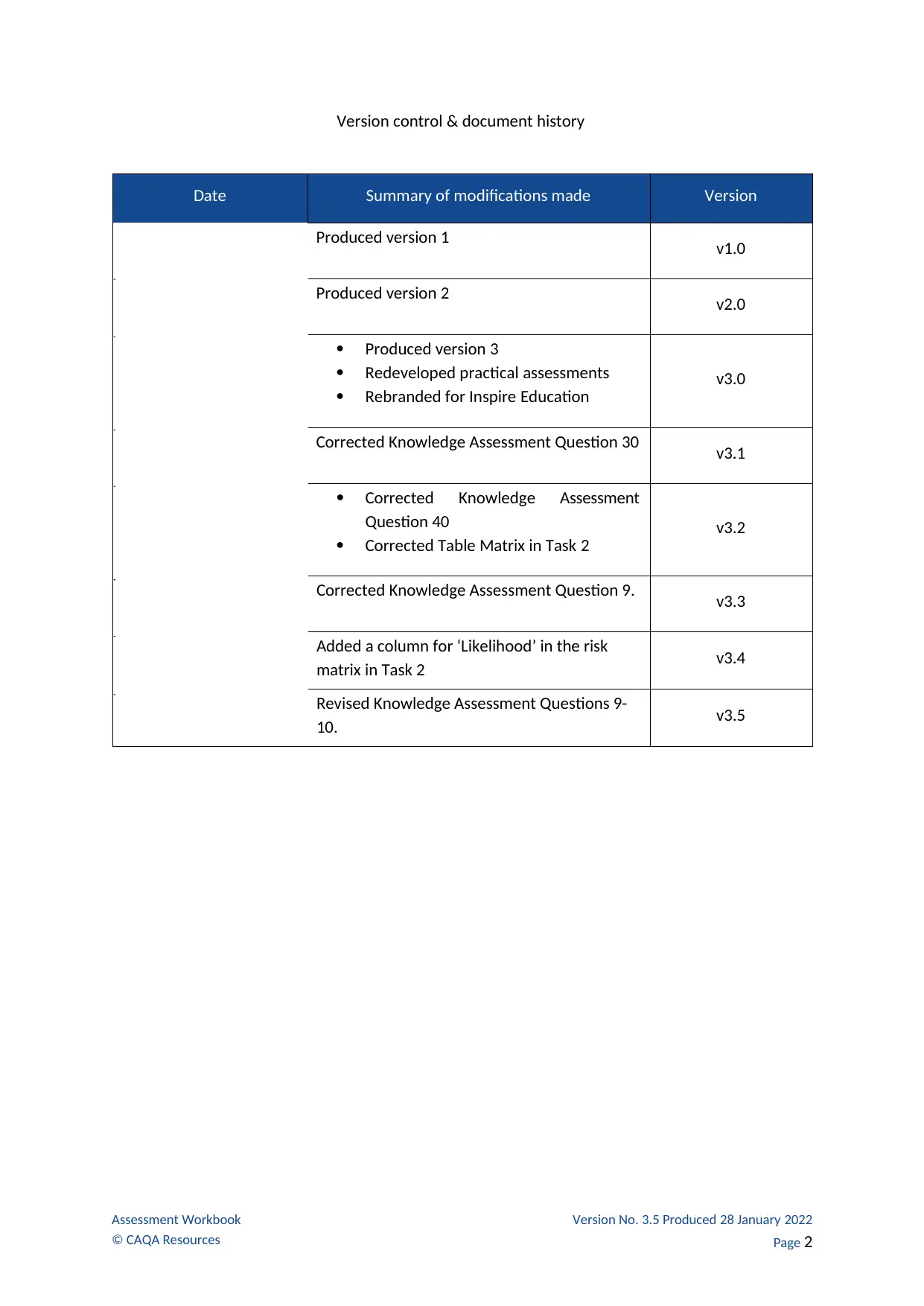
Assessment Workbook
© CAQA Resources
Version No. 3.5 Produced 28 January 2022
Page 2
Version control & document history
Date Summary of modifications made Version
Produced version 1 v1.0
Produced version 2 v2.0
Produced version 3
Redeveloped practical assessments
Rebranded for Inspire Education
v3.0
Corrected Knowledge Assessment Question 30 v3.1
Corrected Knowledge Assessment
Question 40
Corrected Table Matrix in Task 2
v3.2
Corrected Knowledge Assessment Question 9. v3.3
Added a column for ‘Likelihood’ in the risk
matrix in Task 2 v3.4
Revised Knowledge Assessment Questions 9-
10. v3.5
© CAQA Resources
Version No. 3.5 Produced 28 January 2022
Page 2
Version control & document history
Date Summary of modifications made Version
Produced version 1 v1.0
Produced version 2 v2.0
Produced version 3
Redeveloped practical assessments
Rebranded for Inspire Education
v3.0
Corrected Knowledge Assessment Question 30 v3.1
Corrected Knowledge Assessment
Question 40
Corrected Table Matrix in Task 2
v3.2
Corrected Knowledge Assessment Question 9. v3.3
Added a column for ‘Likelihood’ in the risk
matrix in Task 2 v3.4
Revised Knowledge Assessment Questions 9-
10. v3.5
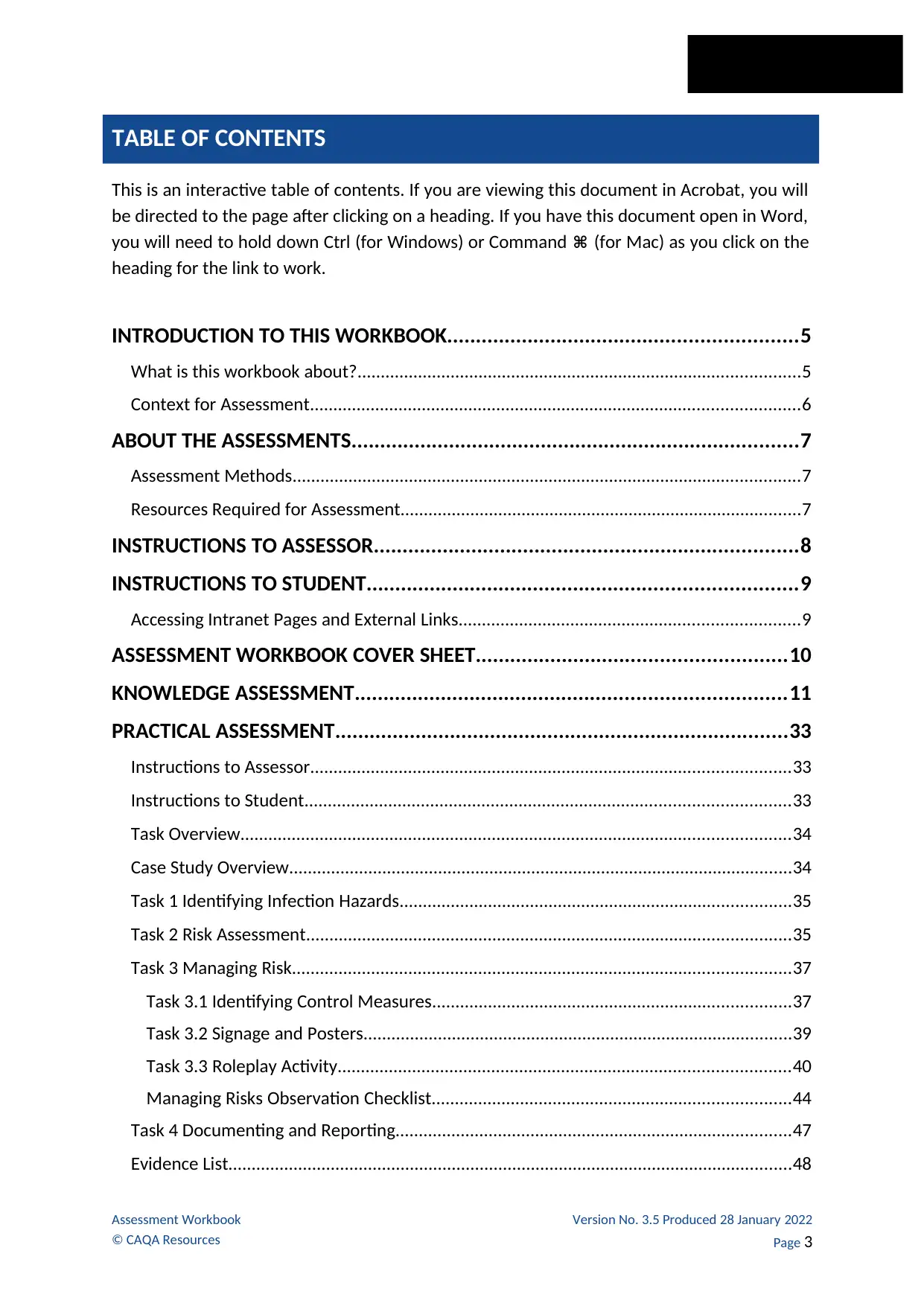
Assessment Workbook
© CAQA Resources
Version No. 3.5 Produced 28 January 2022
Page 3
This is an interactive table of contents. If you are viewing this document in Acrobat, you will
be directed to the page after clicking on a heading. If you have this document open in Word,
you will need to hold down Ctrl (for Windows) or Command ⌘ (for Mac) as you click on the
heading for the link to work.
INTRODUCTION TO THIS WORKBOOK.............................................................5
What is this workbook about?...............................................................................................5
Context for Assessment.........................................................................................................6
ABOUT THE ASSESSMENTS..............................................................................7
Assessment Methods.............................................................................................................7
Resources Required for Assessment......................................................................................7
INSTRUCTIONS TO ASSESSOR..........................................................................8
INSTRUCTIONS TO STUDENT...........................................................................9
Accessing Intranet Pages and External Links.........................................................................9
ASSESSMENT WORKBOOK COVER SHEET......................................................10
KNOWLEDGE ASSESSMENT...........................................................................11
PRACTICAL ASSESSMENT...............................................................................33
Instructions to Assessor.......................................................................................................33
Instructions to Student........................................................................................................33
Task Overview......................................................................................................................34
Case Study Overview............................................................................................................34
Task 1 Identifying Infection Hazards....................................................................................35
Task 2 Risk Assessment........................................................................................................35
Task 3 Managing Risk...........................................................................................................37
Task 3.1 Identifying Control Measures.............................................................................37
Task 3.2 Signage and Posters............................................................................................39
Task 3.3 Roleplay Activity.................................................................................................40
Managing Risks Observation Checklist.............................................................................44
Task 4 Documenting and Reporting.....................................................................................47
Evidence List.........................................................................................................................48
TABLE OF CONTENTS
© CAQA Resources
Version No. 3.5 Produced 28 January 2022
Page 3
This is an interactive table of contents. If you are viewing this document in Acrobat, you will
be directed to the page after clicking on a heading. If you have this document open in Word,
you will need to hold down Ctrl (for Windows) or Command ⌘ (for Mac) as you click on the
heading for the link to work.
INTRODUCTION TO THIS WORKBOOK.............................................................5
What is this workbook about?...............................................................................................5
Context for Assessment.........................................................................................................6
ABOUT THE ASSESSMENTS..............................................................................7
Assessment Methods.............................................................................................................7
Resources Required for Assessment......................................................................................7
INSTRUCTIONS TO ASSESSOR..........................................................................8
INSTRUCTIONS TO STUDENT...........................................................................9
Accessing Intranet Pages and External Links.........................................................................9
ASSESSMENT WORKBOOK COVER SHEET......................................................10
KNOWLEDGE ASSESSMENT...........................................................................11
PRACTICAL ASSESSMENT...............................................................................33
Instructions to Assessor.......................................................................................................33
Instructions to Student........................................................................................................33
Task Overview......................................................................................................................34
Case Study Overview............................................................................................................34
Task 1 Identifying Infection Hazards....................................................................................35
Task 2 Risk Assessment........................................................................................................35
Task 3 Managing Risk...........................................................................................................37
Task 3.1 Identifying Control Measures.............................................................................37
Task 3.2 Signage and Posters............................................................................................39
Task 3.3 Roleplay Activity.................................................................................................40
Managing Risks Observation Checklist.............................................................................44
Task 4 Documenting and Reporting.....................................................................................47
Evidence List.........................................................................................................................48
TABLE OF CONTENTS
⊘ This is a preview!⊘
Do you want full access?
Subscribe today to unlock all pages.

Trusted by 1+ million students worldwide
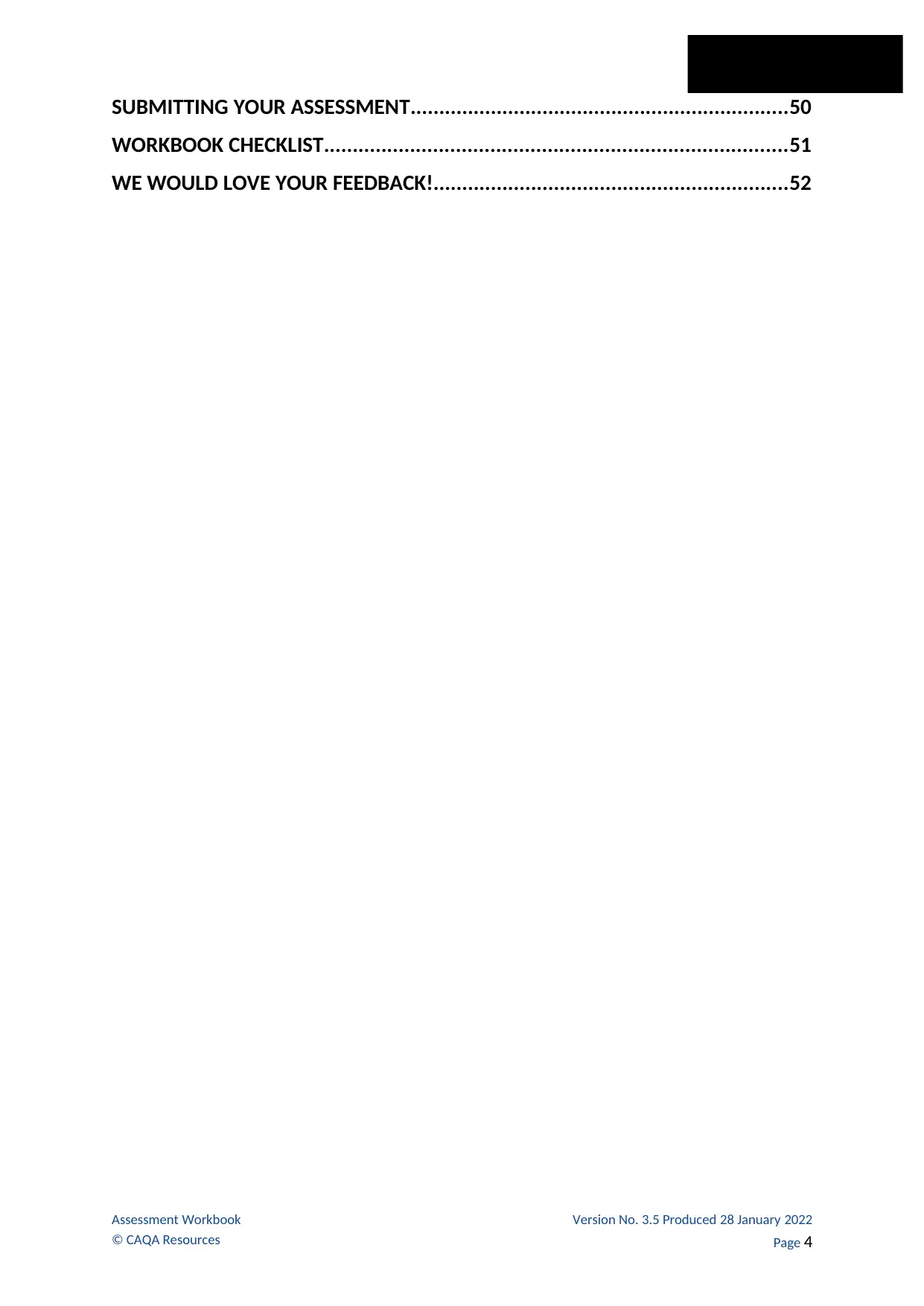
Assessment Workbook
© CAQA Resources
Version No. 3.5 Produced 28 January 2022
Page 4
SUBMITTING YOUR ASSESSMENT..................................................................50
WORKBOOK CHECKLIST.................................................................................51
WE WOULD LOVE YOUR FEEDBACK!..............................................................52
© CAQA Resources
Version No. 3.5 Produced 28 January 2022
Page 4
SUBMITTING YOUR ASSESSMENT..................................................................50
WORKBOOK CHECKLIST.................................................................................51
WE WOULD LOVE YOUR FEEDBACK!..............................................................52
Paraphrase This Document
Need a fresh take? Get an instant paraphrase of this document with our AI Paraphraser

Assessment Workbook
© CAQA Resources
Version No. 3.5 Produced 28 January 2022
Page 5
What is this workbook about?
The units of competency specify the standards of performance required in the workplace.
This assessment addresses the following unit of competency:
HLTINF001 - Comply with infection prevention and control policies and procedures
1. Follow standard and additional precautions for infection prevention and control
2. Identify infection hazards and assess risks
3. Follow procedures for managing risks associated with specific hazards
For complete copies of the above units of competency,
download them from the TGA website
https://training.gov.au/training/details/hltinf001
INTRODUCTION TO THIS WORKBOOK
© CAQA Resources
Version No. 3.5 Produced 28 January 2022
Page 5
What is this workbook about?
The units of competency specify the standards of performance required in the workplace.
This assessment addresses the following unit of competency:
HLTINF001 - Comply with infection prevention and control policies and procedures
1. Follow standard and additional precautions for infection prevention and control
2. Identify infection hazards and assess risks
3. Follow procedures for managing risks associated with specific hazards
For complete copies of the above units of competency,
download them from the TGA website
https://training.gov.au/training/details/hltinf001
INTRODUCTION TO THIS WORKBOOK

Assessment Workbook
© CAQA Resources
Version No. 3.5 Produced 28 January 2022
Page 6
Context for Assessment
To complete the assessments in this workbook, students need to have access to their
learning materials and the Internet. The assessment activities may be completed wholly at
the student’s home or chosen place of study.
The associated assessment method in this kit covers all of these components as detailed
in the matrix to follow:
Units of
Competency
Assessment Activities
HLTINF001
Knowledge Assessment
Practical Assessment
© CAQA Resources
Version No. 3.5 Produced 28 January 2022
Page 6
Context for Assessment
To complete the assessments in this workbook, students need to have access to their
learning materials and the Internet. The assessment activities may be completed wholly at
the student’s home or chosen place of study.
The associated assessment method in this kit covers all of these components as detailed
in the matrix to follow:
Units of
Competency
Assessment Activities
HLTINF001
Knowledge Assessment
Practical Assessment
⊘ This is a preview!⊘
Do you want full access?
Subscribe today to unlock all pages.

Trusted by 1+ million students worldwide

Assessment Workbook
© CAQA Resources
Version No. 3.5 Produced 28 January 2022
Page 7
Assessment Methods
1. Knowledge Assessment - Written assessments to test students’ understanding of
underpinning knowledge, concepts and/or theories relevant to the units of
competency included in this subject.
2. Practical Assessment - A task or activity completed according to set instructions
and guidelines to meet the requirements of the relevant units.
Resources Required for Assessment
Assessor to provide:
Templates needed for tasks such as survey forms and report template.
Case studies and simulations
Information about work activities
You will need access to:
Office equipment and resources
Computer with internet access
Word processing computer program that can save and edit these file types:
MS Office Word file formats (documents)
PDF file format
A video recording device
Printer or e-printer
ABOUT THE ASSESSMENTS
© CAQA Resources
Version No. 3.5 Produced 28 January 2022
Page 7
Assessment Methods
1. Knowledge Assessment - Written assessments to test students’ understanding of
underpinning knowledge, concepts and/or theories relevant to the units of
competency included in this subject.
2. Practical Assessment - A task or activity completed according to set instructions
and guidelines to meet the requirements of the relevant units.
Resources Required for Assessment
Assessor to provide:
Templates needed for tasks such as survey forms and report template.
Case studies and simulations
Information about work activities
You will need access to:
Office equipment and resources
Computer with internet access
Word processing computer program that can save and edit these file types:
MS Office Word file formats (documents)
PDF file format
A video recording device
Printer or e-printer
ABOUT THE ASSESSMENTS
Paraphrase This Document
Need a fresh take? Get an instant paraphrase of this document with our AI Paraphraser
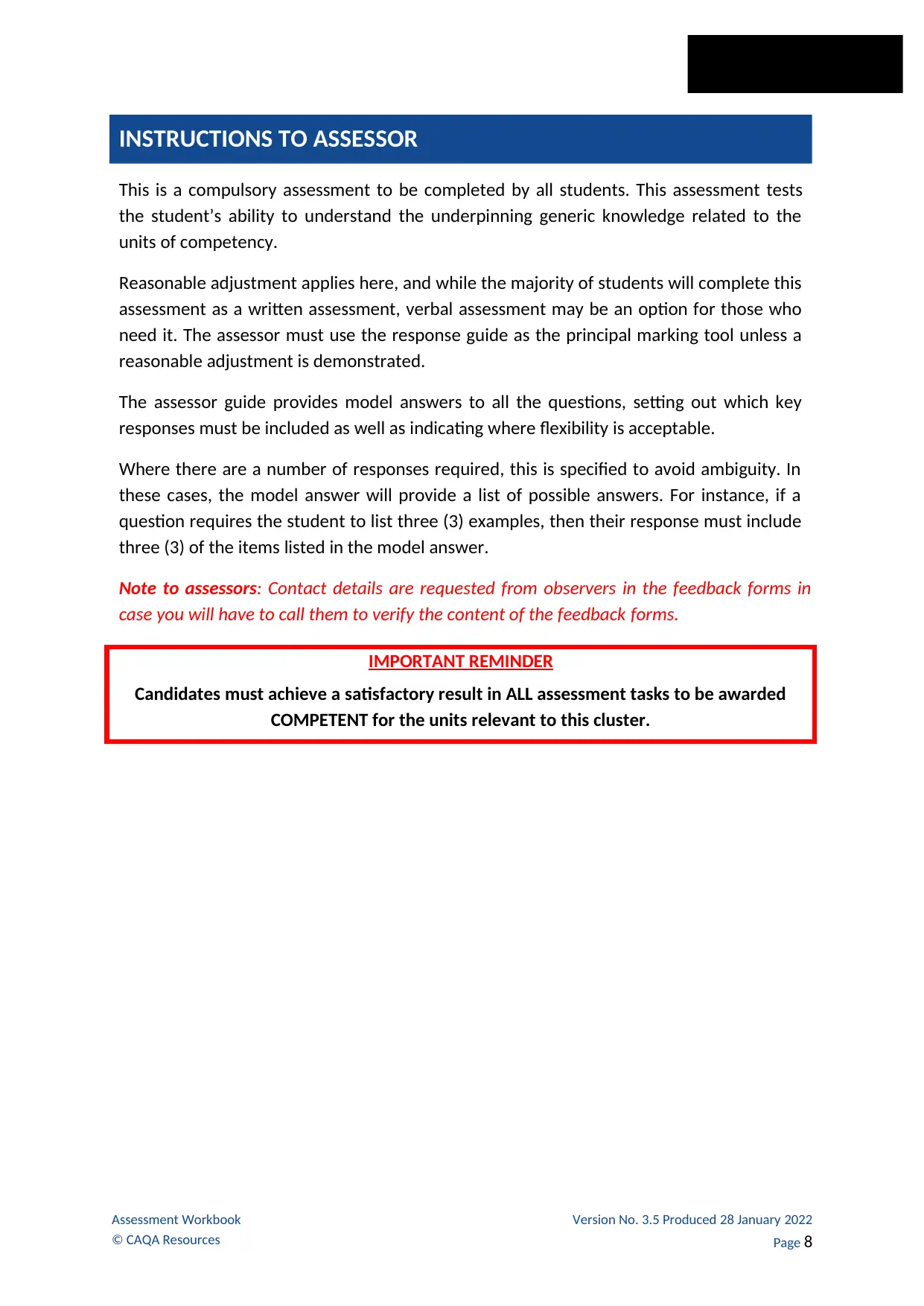
INSTRUCTIONS TO ASSESSOR
Assessment Workbook
© CAQA Resources
Version No. 3.5 Produced 28 January 2022
Page 8
This is a compulsory assessment to be completed by all students. This assessment tests
the student’s ability to understand the underpinning generic knowledge related to the
units of competency.
Reasonable adjustment applies here, and while the majority of students will complete this
assessment as a written assessment, verbal assessment may be an option for those who
need it. The assessor must use the response guide as the principal marking tool unless a
reasonable adjustment is demonstrated.
The assessor guide provides model answers to all the questions, setting out which key
responses must be included as well as indicating where flexibility is acceptable.
Where there are a number of responses required, this is specified to avoid ambiguity. In
these cases, the model answer will provide a list of possible answers. For instance, if a
question requires the student to list three (3) examples, then their response must include
three (3) of the items listed in the model answer.
Note to assessors: Contact details are requested from observers in the feedback forms in
case you will have to call them to verify the content of the feedback forms.
IMPORTANT REMINDER
Candidates must achieve a satisfactory result in ALL assessment tasks to be awarded
COMPETENT for the units relevant to this cluster.
Assessment Workbook
© CAQA Resources
Version No. 3.5 Produced 28 January 2022
Page 8
This is a compulsory assessment to be completed by all students. This assessment tests
the student’s ability to understand the underpinning generic knowledge related to the
units of competency.
Reasonable adjustment applies here, and while the majority of students will complete this
assessment as a written assessment, verbal assessment may be an option for those who
need it. The assessor must use the response guide as the principal marking tool unless a
reasonable adjustment is demonstrated.
The assessor guide provides model answers to all the questions, setting out which key
responses must be included as well as indicating where flexibility is acceptable.
Where there are a number of responses required, this is specified to avoid ambiguity. In
these cases, the model answer will provide a list of possible answers. For instance, if a
question requires the student to list three (3) examples, then their response must include
three (3) of the items listed in the model answer.
Note to assessors: Contact details are requested from observers in the feedback forms in
case you will have to call them to verify the content of the feedback forms.
IMPORTANT REMINDER
Candidates must achieve a satisfactory result in ALL assessment tasks to be awarded
COMPETENT for the units relevant to this cluster.
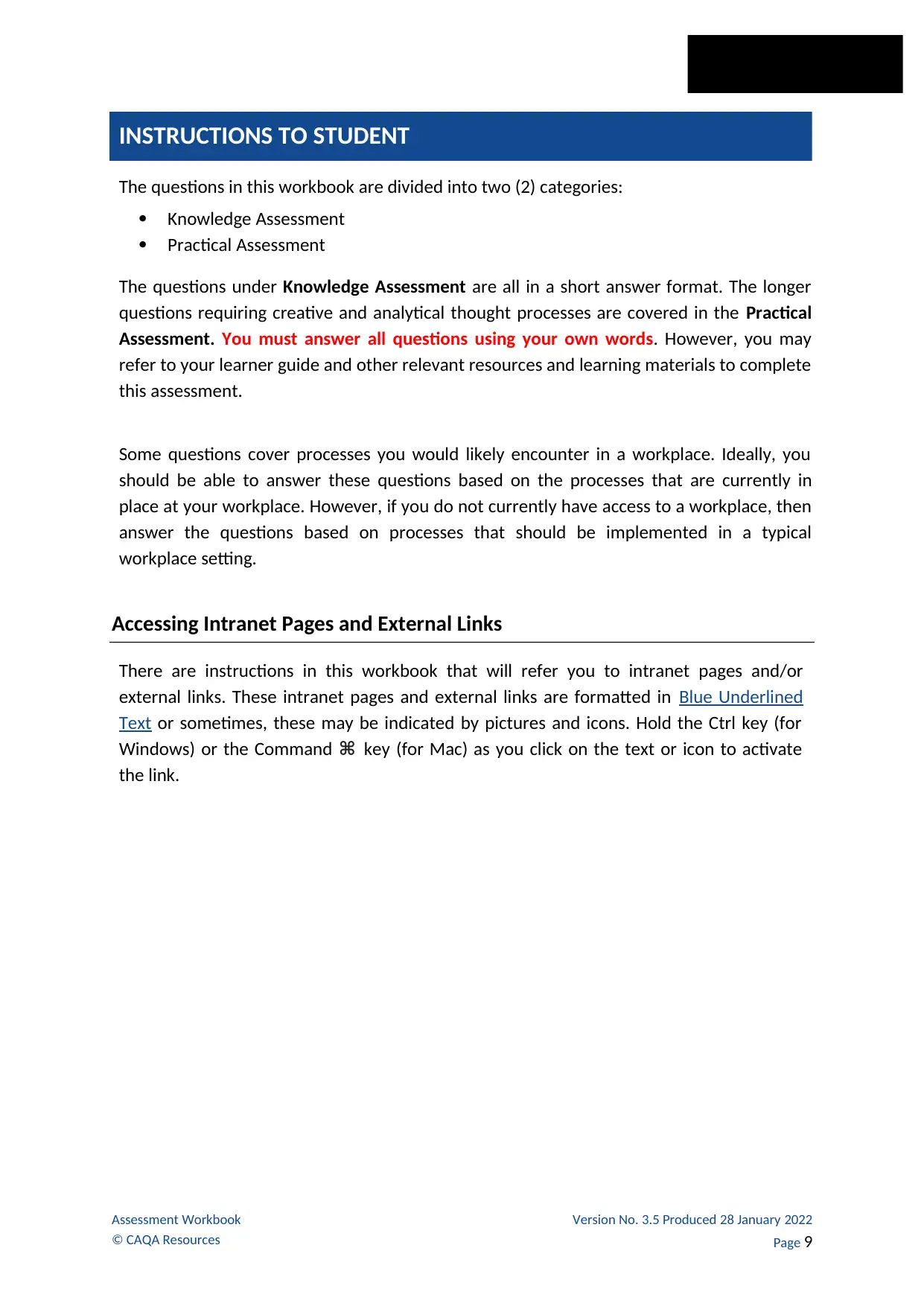
INSTRUCTIONS TO STUDENT
Assessment Workbook
© CAQA Resources
Version No. 3.5 Produced 28 January 2022
Page 9
The questions in this workbook are divided into two (2) categories:
Knowledge Assessment
Practical Assessment
The questions under Knowledge Assessment are all in a short answer format. The longer
questions requiring creative and analytical thought processes are covered in the Practical
Assessment. You must answer all questions using your own words. However, you may
refer to your learner guide and other relevant resources and learning materials to complete
this assessment.
Some questions cover processes you would likely encounter in a workplace. Ideally, you
should be able to answer these questions based on the processes that are currently in
place at your workplace. However, if you do not currently have access to a workplace, then
answer the questions based on processes that should be implemented in a typical
workplace setting.
Accessing Intranet Pages and External Links
There are instructions in this workbook that will refer you to intranet pages and/or
external links. These intranet pages and external links are formatted in Blue Underlined
Text or sometimes, these may be indicated by pictures and icons. Hold the Ctrl key (for
Windows) or the Command ⌘ key (for Mac) as you click on the text or icon to activate
the link.
Assessment Workbook
© CAQA Resources
Version No. 3.5 Produced 28 January 2022
Page 9
The questions in this workbook are divided into two (2) categories:
Knowledge Assessment
Practical Assessment
The questions under Knowledge Assessment are all in a short answer format. The longer
questions requiring creative and analytical thought processes are covered in the Practical
Assessment. You must answer all questions using your own words. However, you may
refer to your learner guide and other relevant resources and learning materials to complete
this assessment.
Some questions cover processes you would likely encounter in a workplace. Ideally, you
should be able to answer these questions based on the processes that are currently in
place at your workplace. However, if you do not currently have access to a workplace, then
answer the questions based on processes that should be implemented in a typical
workplace setting.
Accessing Intranet Pages and External Links
There are instructions in this workbook that will refer you to intranet pages and/or
external links. These intranet pages and external links are formatted in Blue Underlined
Text or sometimes, these may be indicated by pictures and icons. Hold the Ctrl key (for
Windows) or the Command ⌘ key (for Mac) as you click on the text or icon to activate
the link.
⊘ This is a preview!⊘
Do you want full access?
Subscribe today to unlock all pages.

Trusted by 1+ million students worldwide

ASSESSMENT WORKBOOK COVER SHEET
Assessment Workbook
© CAQA Resources
Version No. 3.5 Produced 28 January 2022
Page 10
WORKBOOK: Click or tap here to enter text.
TITLE: Click or tap here to enter text.
FIRST AND SURNAME:
PHONE:
EMAIL:
Please read the Candidate Declaration below and if you agree to the terms
of the declaration sign and date in the space provided.
By submitting this work, I declare that:
I have been advised of the assessment requirements, have been made aware of my
rights and responsibilities as an assessment candidate, and choose to be assessed at
this time.
I am aware that there is a limit to the number of submissions that I can make for each
assessment, and I am submitting all documents required to complete this Assessment
Workbook.
I have organised and named the files I am submitting according to the instructions
provided, and I am aware that my assessor will not assess work that cannot be clearly
identified and may request the work be resubmitted according to the correct process.
This work is my own and contains no material written by another person except where
due reference is made. I am aware that a false declaration may lead to the withdrawal
of a qualification or statement of attainment.
I am aware that there is a policy of checking the validity of qualifications that I submit
as evidence as well as the qualifications/evidence of parties who verify my
performance or observable skills. I give my consent to contact these parties for
verification purposes.
Name: Signature: Date:
Assessment Workbook
© CAQA Resources
Version No. 3.5 Produced 28 January 2022
Page 10
WORKBOOK: Click or tap here to enter text.
TITLE: Click or tap here to enter text.
FIRST AND SURNAME:
PHONE:
EMAIL:
Please read the Candidate Declaration below and if you agree to the terms
of the declaration sign and date in the space provided.
By submitting this work, I declare that:
I have been advised of the assessment requirements, have been made aware of my
rights and responsibilities as an assessment candidate, and choose to be assessed at
this time.
I am aware that there is a limit to the number of submissions that I can make for each
assessment, and I am submitting all documents required to complete this Assessment
Workbook.
I have organised and named the files I am submitting according to the instructions
provided, and I am aware that my assessor will not assess work that cannot be clearly
identified and may request the work be resubmitted according to the correct process.
This work is my own and contains no material written by another person except where
due reference is made. I am aware that a false declaration may lead to the withdrawal
of a qualification or statement of attainment.
I am aware that there is a policy of checking the validity of qualifications that I submit
as evidence as well as the qualifications/evidence of parties who verify my
performance or observable skills. I give my consent to contact these parties for
verification purposes.
Name: Signature: Date:
Paraphrase This Document
Need a fresh take? Get an instant paraphrase of this document with our AI Paraphraser

Assessment Workbook
© CAQA Resources
Version No. 3.5 Produced 28 January 2022
Page 11
1. Why is handwashing important in infection control?
Washing hands prevents illnesses and spread of infections to others Handwashing with
soap removes germs from hands. This helps prevent infections because: People
frequently touch their eyes, nose, and mouth without even realizing it.
2. What are the mandatory steps in proper handwashing?
•
•
•
Wet the hands under running water and apply soap to cover the wrist and hands.
Rub the hands together covering the back of palms,finger tips, nails and wrist.
Follow these movements while handwashing: palm to palm, rub back of each
palmalternatively, interlace the fingers and rub both palms, swap after cupping the hands
with
the fingers interlocked and one palm over the other, rotate each thumps alternatively,
rub the fingers on the center of each palm alternatively.
Continue the process of cleaning hands for at least 20 seconds.
Wash the hands under an open tap (running water).
Use a disposable towel to turn off the tap
Dry hands with a clean and dry towel.
3. Identify five (5) times when hand hygiene is most important.
1.
2.
Cleaning hands before touching a patient
Cleaning hands before a procedure
KNOWLEDGE ASSESSMENT
© CAQA Resources
Version No. 3.5 Produced 28 January 2022
Page 11
1. Why is handwashing important in infection control?
Washing hands prevents illnesses and spread of infections to others Handwashing with
soap removes germs from hands. This helps prevent infections because: People
frequently touch their eyes, nose, and mouth without even realizing it.
2. What are the mandatory steps in proper handwashing?
•
•
•
Wet the hands under running water and apply soap to cover the wrist and hands.
Rub the hands together covering the back of palms,finger tips, nails and wrist.
Follow these movements while handwashing: palm to palm, rub back of each
palmalternatively, interlace the fingers and rub both palms, swap after cupping the hands
with
the fingers interlocked and one palm over the other, rotate each thumps alternatively,
rub the fingers on the center of each palm alternatively.
Continue the process of cleaning hands for at least 20 seconds.
Wash the hands under an open tap (running water).
Use a disposable towel to turn off the tap
Dry hands with a clean and dry towel.
3. Identify five (5) times when hand hygiene is most important.
1.
2.
Cleaning hands before touching a patient
Cleaning hands before a procedure
KNOWLEDGE ASSESSMENT
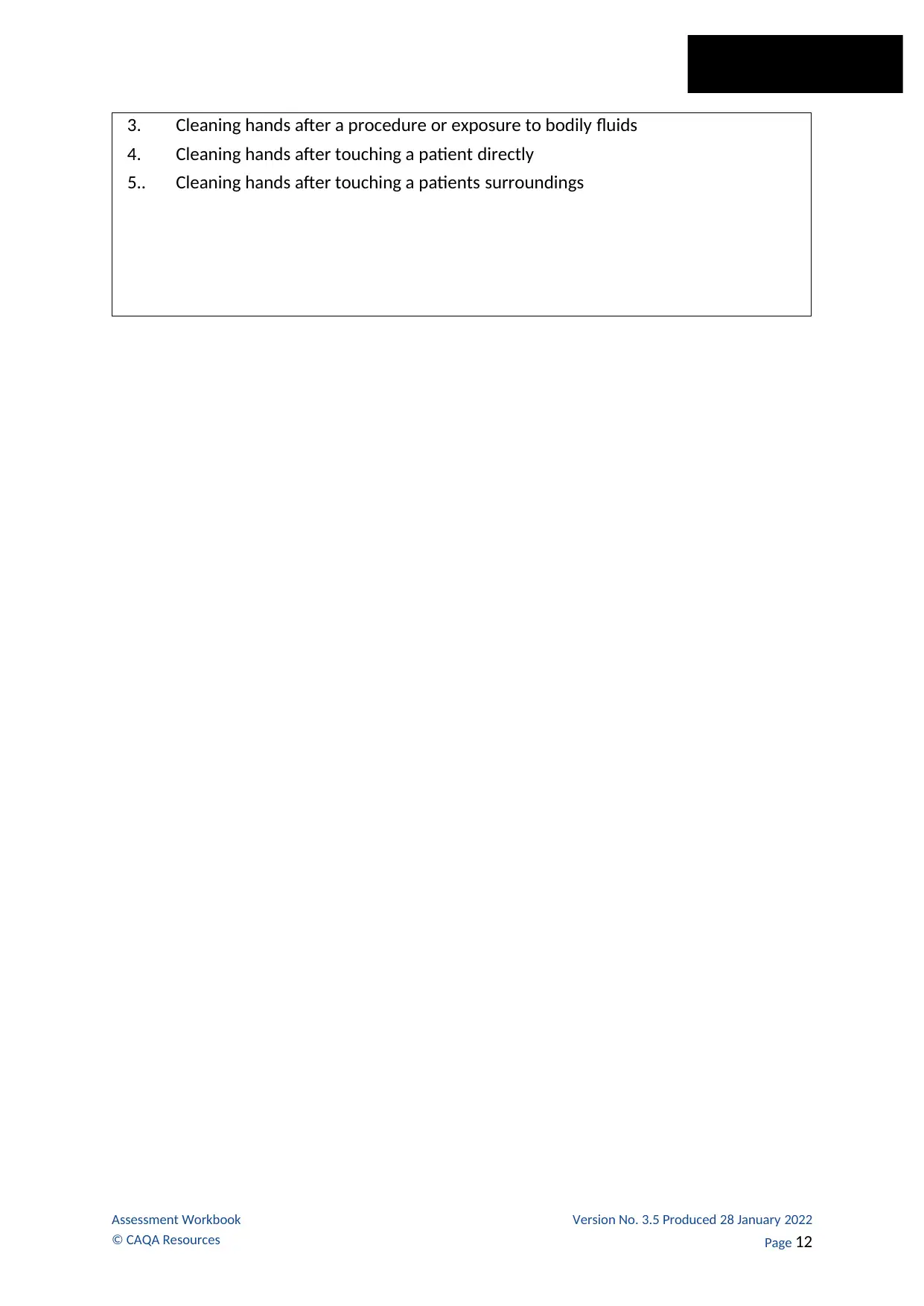
Assessment Workbook
© CAQA Resources
Version No. 3.5 Produced 28 January 2022
Page 12
3. Cleaning hands after a procedure or exposure to bodily fluids
4. Cleaning hands after touching a patient directly
5.. Cleaning hands after touching a patients surroundings
© CAQA Resources
Version No. 3.5 Produced 28 January 2022
Page 12
3. Cleaning hands after a procedure or exposure to bodily fluids
4. Cleaning hands after touching a patient directly
5.. Cleaning hands after touching a patients surroundings
⊘ This is a preview!⊘
Do you want full access?
Subscribe today to unlock all pages.

Trusted by 1+ million students worldwide
1 out of 54
Related Documents
Your All-in-One AI-Powered Toolkit for Academic Success.
+13062052269
info@desklib.com
Available 24*7 on WhatsApp / Email
![[object Object]](/_next/static/media/star-bottom.7253800d.svg)
Unlock your academic potential
Copyright © 2020–2025 A2Z Services. All Rights Reserved. Developed and managed by ZUCOL.





